Risks and Ethical Issues in Startup Launching
VerifiedAdded on 2023/01/16
|11
|2654
|86
AI Summary
This report discusses the various risks and ethical issues faced by entrepreneurs during launching a startup. It also identifies the top three risks and provides insights from both entrepreneurs and investors.
Contribute Materials
Your contribution can guide someone’s learning journey. Share your
documents today.

Running head: MANAGEMENT
Management
Name of the Student
Name of the University
Author Note
Management
Name of the Student
Name of the University
Author Note
Secure Best Marks with AI Grader
Need help grading? Try our AI Grader for instant feedback on your assignments.
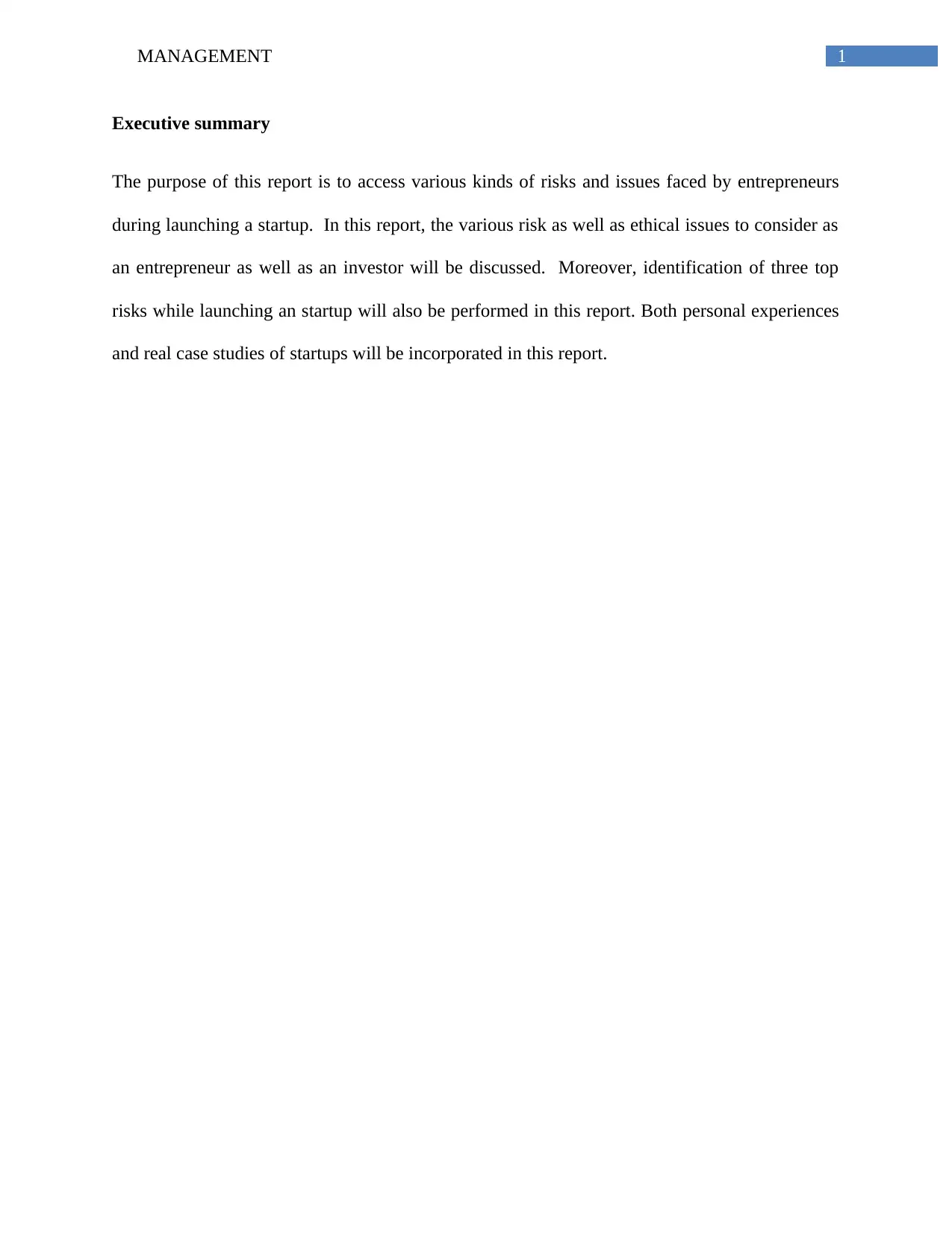
1MANAGEMENT
Executive summary
The purpose of this report is to access various kinds of risks and issues faced by entrepreneurs
during launching a startup. In this report, the various risk as well as ethical issues to consider as
an entrepreneur as well as an investor will be discussed. Moreover, identification of three top
risks while launching an startup will also be performed in this report. Both personal experiences
and real case studies of startups will be incorporated in this report.
Executive summary
The purpose of this report is to access various kinds of risks and issues faced by entrepreneurs
during launching a startup. In this report, the various risk as well as ethical issues to consider as
an entrepreneur as well as an investor will be discussed. Moreover, identification of three top
risks while launching an startup will also be performed in this report. Both personal experiences
and real case studies of startups will be incorporated in this report.
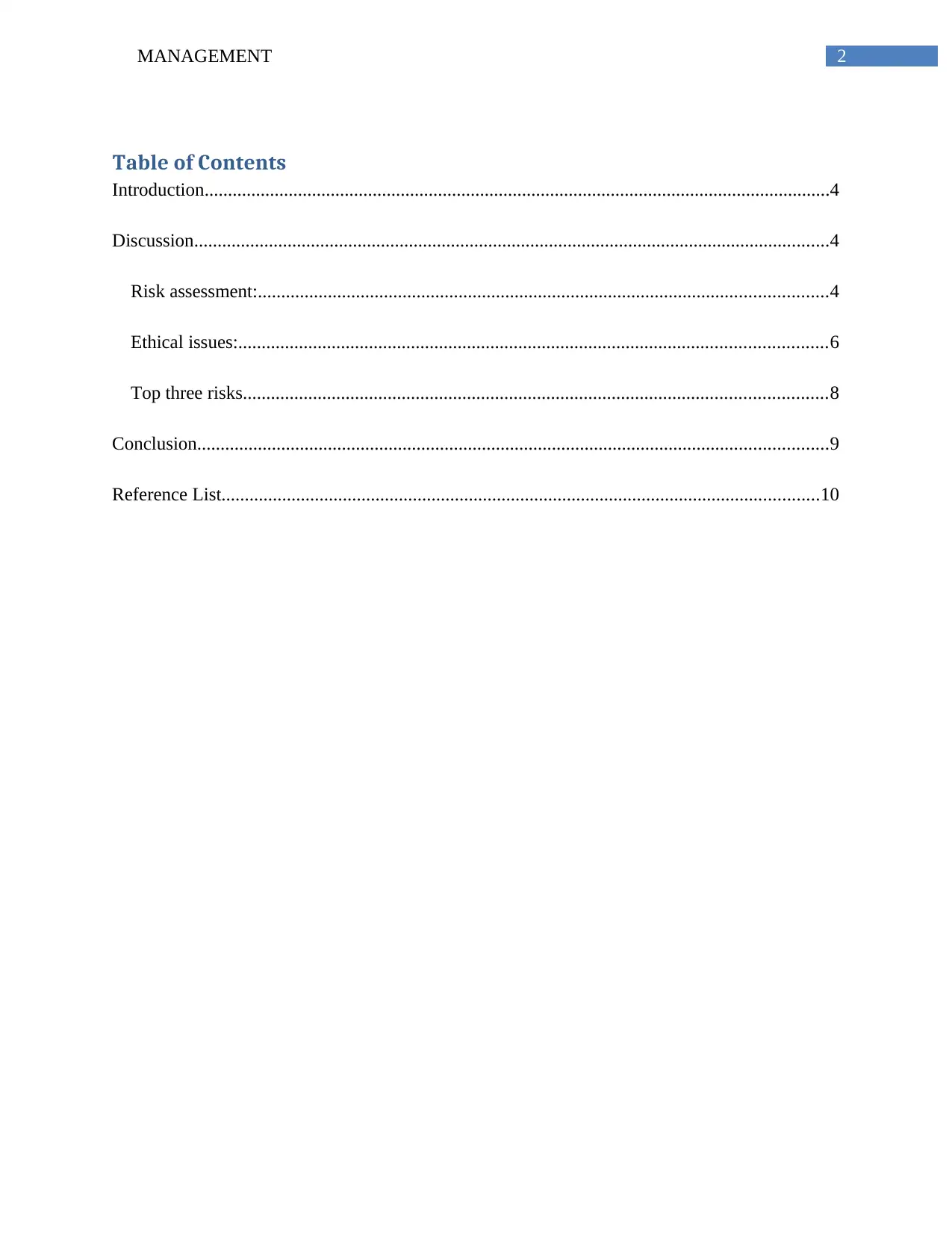
2MANAGEMENT
Table of Contents
Introduction......................................................................................................................................4
Discussion........................................................................................................................................4
Risk assessment:..........................................................................................................................4
Ethical issues:..............................................................................................................................6
Top three risks.............................................................................................................................8
Conclusion.......................................................................................................................................9
Reference List................................................................................................................................10
Table of Contents
Introduction......................................................................................................................................4
Discussion........................................................................................................................................4
Risk assessment:..........................................................................................................................4
Ethical issues:..............................................................................................................................6
Top three risks.............................................................................................................................8
Conclusion.......................................................................................................................................9
Reference List................................................................................................................................10
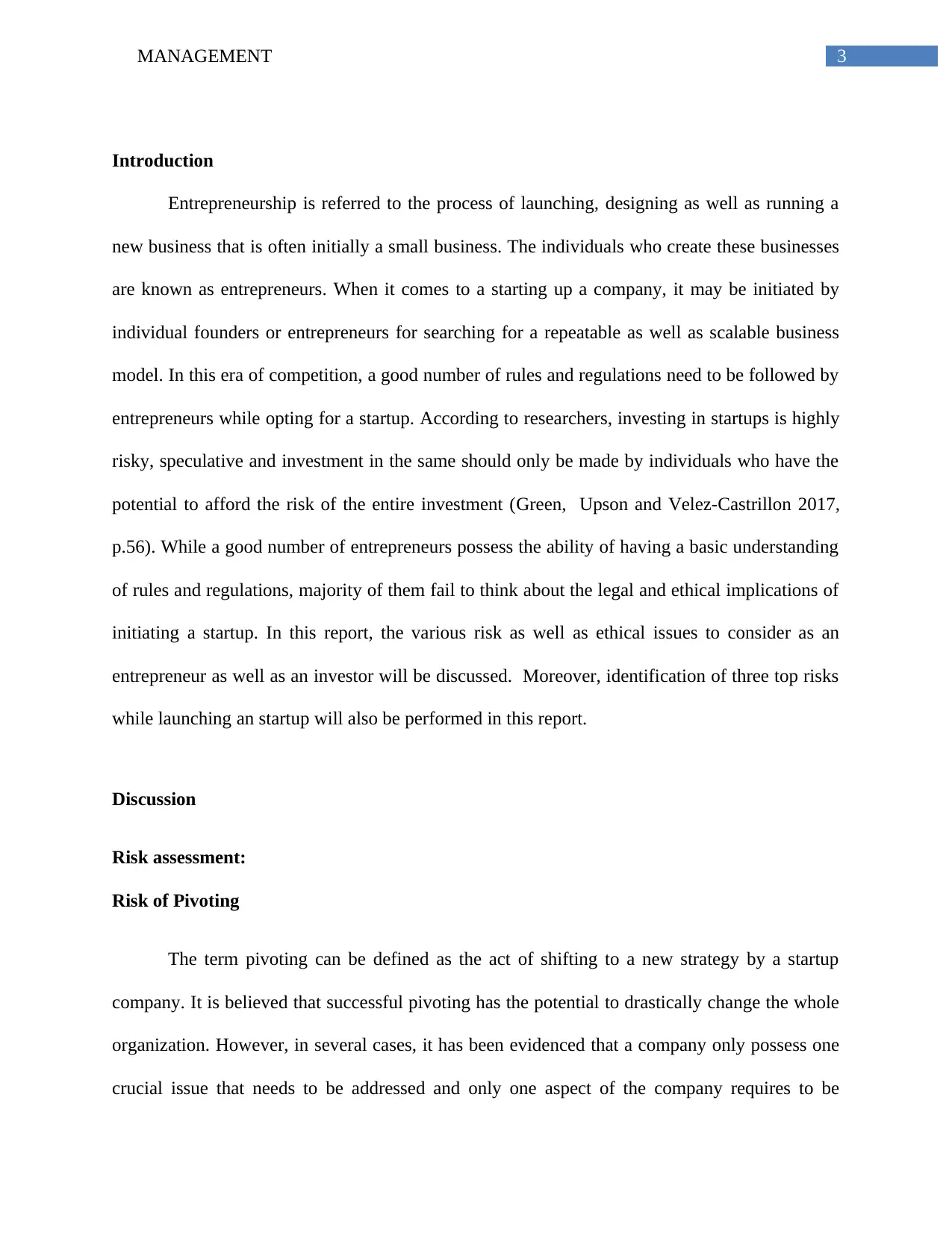
3MANAGEMENT
Introduction
Entrepreneurship is referred to the process of launching, designing as well as running a
new business that is often initially a small business. The individuals who create these businesses
are known as entrepreneurs. When it comes to a starting up a company, it may be initiated by
individual founders or entrepreneurs for searching for a repeatable as well as scalable business
model. In this era of competition, a good number of rules and regulations need to be followed by
entrepreneurs while opting for a startup. According to researchers, investing in startups is highly
risky, speculative and investment in the same should only be made by individuals who have the
potential to afford the risk of the entire investment (Green, Upson and Velez-Castrillon 2017,
p.56). While a good number of entrepreneurs possess the ability of having a basic understanding
of rules and regulations, majority of them fail to think about the legal and ethical implications of
initiating a startup. In this report, the various risk as well as ethical issues to consider as an
entrepreneur as well as an investor will be discussed. Moreover, identification of three top risks
while launching an startup will also be performed in this report.
Discussion
Risk assessment:
Risk of Pivoting
The term pivoting can be defined as the act of shifting to a new strategy by a startup
company. It is believed that successful pivoting has the potential to drastically change the whole
organization. However, in several cases, it has been evidenced that a company only possess one
crucial issue that needs to be addressed and only one aspect of the company requires to be
Introduction
Entrepreneurship is referred to the process of launching, designing as well as running a
new business that is often initially a small business. The individuals who create these businesses
are known as entrepreneurs. When it comes to a starting up a company, it may be initiated by
individual founders or entrepreneurs for searching for a repeatable as well as scalable business
model. In this era of competition, a good number of rules and regulations need to be followed by
entrepreneurs while opting for a startup. According to researchers, investing in startups is highly
risky, speculative and investment in the same should only be made by individuals who have the
potential to afford the risk of the entire investment (Green, Upson and Velez-Castrillon 2017,
p.56). While a good number of entrepreneurs possess the ability of having a basic understanding
of rules and regulations, majority of them fail to think about the legal and ethical implications of
initiating a startup. In this report, the various risk as well as ethical issues to consider as an
entrepreneur as well as an investor will be discussed. Moreover, identification of three top risks
while launching an startup will also be performed in this report.
Discussion
Risk assessment:
Risk of Pivoting
The term pivoting can be defined as the act of shifting to a new strategy by a startup
company. It is believed that successful pivoting has the potential to drastically change the whole
organization. However, in several cases, it has been evidenced that a company only possess one
crucial issue that needs to be addressed and only one aspect of the company requires to be
Secure Best Marks with AI Grader
Need help grading? Try our AI Grader for instant feedback on your assignments.
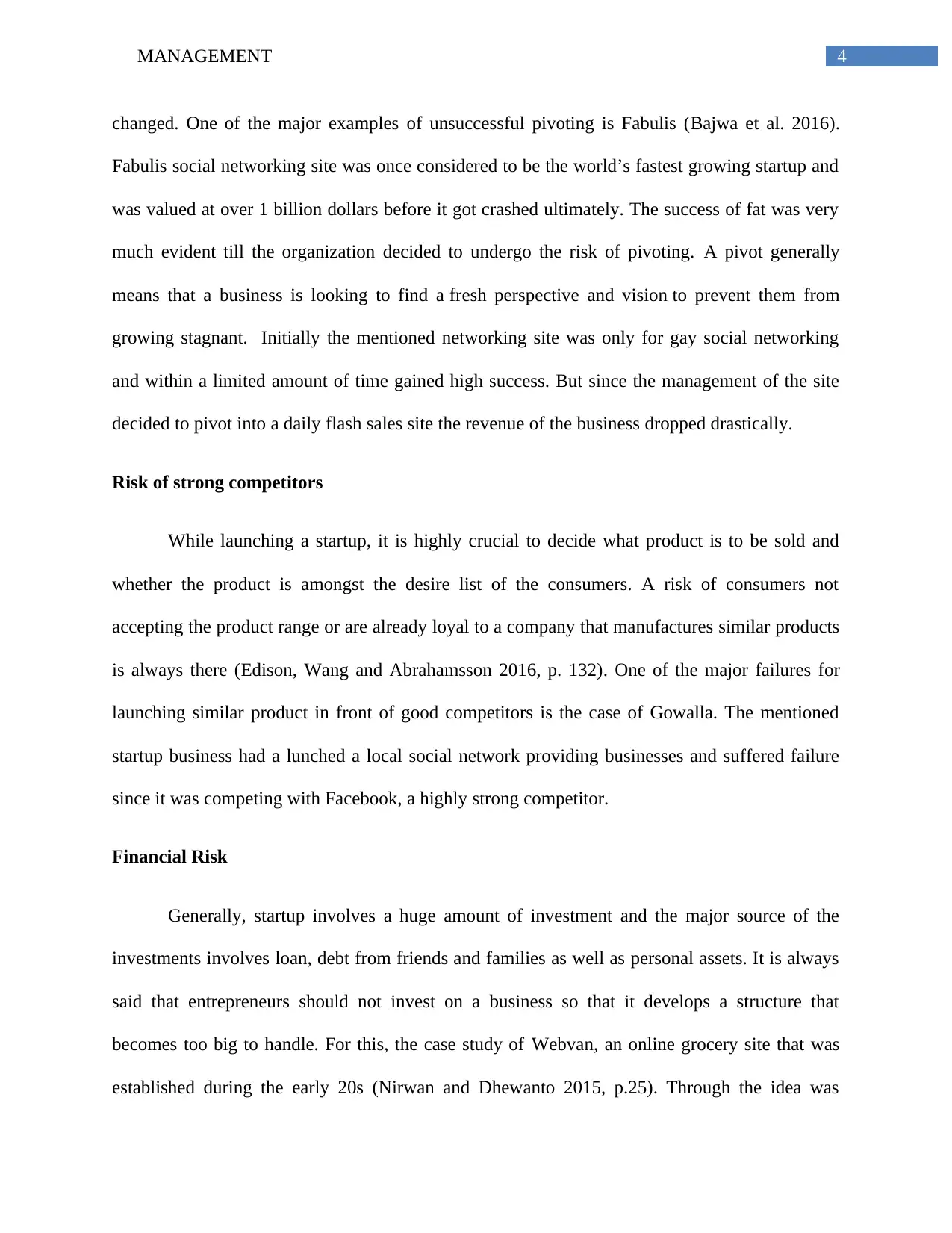
4MANAGEMENT
changed. One of the major examples of unsuccessful pivoting is Fabulis (Bajwa et al. 2016).
Fabulis social networking site was once considered to be the world’s fastest growing startup and
was valued at over 1 billion dollars before it got crashed ultimately. The success of fat was very
much evident till the organization decided to undergo the risk of pivoting. A pivot generally
means that a business is looking to find a fresh perspective and vision to prevent them from
growing stagnant. Initially the mentioned networking site was only for gay social networking
and within a limited amount of time gained high success. But since the management of the site
decided to pivot into a daily flash sales site the revenue of the business dropped drastically.
Risk of strong competitors
While launching a startup, it is highly crucial to decide what product is to be sold and
whether the product is amongst the desire list of the consumers. A risk of consumers not
accepting the product range or are already loyal to a company that manufactures similar products
is always there (Edison, Wang and Abrahamsson 2016, p. 132). One of the major failures for
launching similar product in front of good competitors is the case of Gowalla. The mentioned
startup business had a lunched a local social network providing businesses and suffered failure
since it was competing with Facebook, a highly strong competitor.
Financial Risk
Generally, startup involves a huge amount of investment and the major source of the
investments involves loan, debt from friends and families as well as personal assets. It is always
said that entrepreneurs should not invest on a business so that it develops a structure that
becomes too big to handle. For this, the case study of Webvan, an online grocery site that was
established during the early 20s (Nirwan and Dhewanto 2015, p.25). Through the idea was
changed. One of the major examples of unsuccessful pivoting is Fabulis (Bajwa et al. 2016).
Fabulis social networking site was once considered to be the world’s fastest growing startup and
was valued at over 1 billion dollars before it got crashed ultimately. The success of fat was very
much evident till the organization decided to undergo the risk of pivoting. A pivot generally
means that a business is looking to find a fresh perspective and vision to prevent them from
growing stagnant. Initially the mentioned networking site was only for gay social networking
and within a limited amount of time gained high success. But since the management of the site
decided to pivot into a daily flash sales site the revenue of the business dropped drastically.
Risk of strong competitors
While launching a startup, it is highly crucial to decide what product is to be sold and
whether the product is amongst the desire list of the consumers. A risk of consumers not
accepting the product range or are already loyal to a company that manufactures similar products
is always there (Edison, Wang and Abrahamsson 2016, p. 132). One of the major failures for
launching similar product in front of good competitors is the case of Gowalla. The mentioned
startup business had a lunched a local social network providing businesses and suffered failure
since it was competing with Facebook, a highly strong competitor.
Financial Risk
Generally, startup involves a huge amount of investment and the major source of the
investments involves loan, debt from friends and families as well as personal assets. It is always
said that entrepreneurs should not invest on a business so that it develops a structure that
becomes too big to handle. For this, the case study of Webvan, an online grocery site that was
established during the early 20s (Nirwan and Dhewanto 2015, p.25). Through the idea was
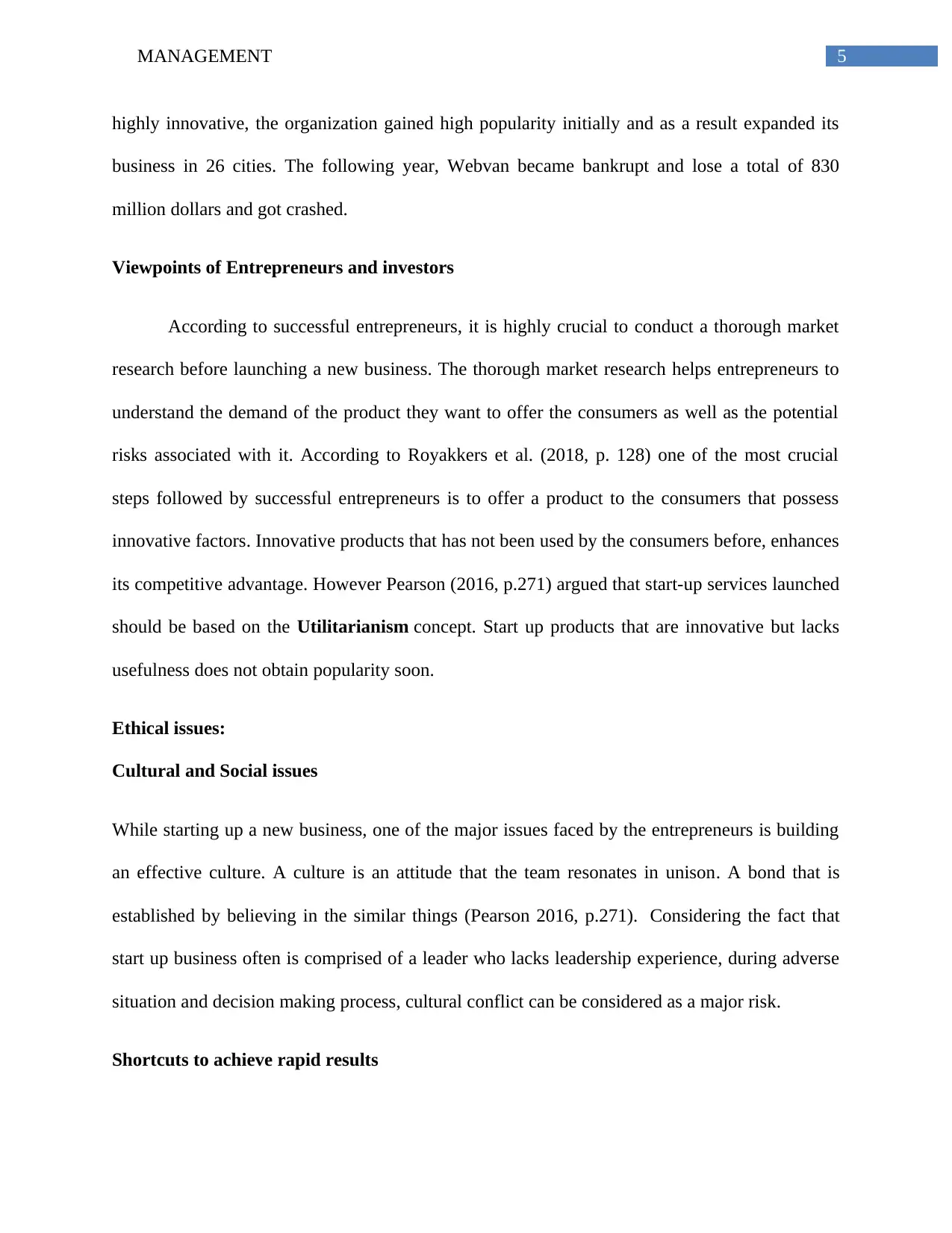
5MANAGEMENT
highly innovative, the organization gained high popularity initially and as a result expanded its
business in 26 cities. The following year, Webvan became bankrupt and lose a total of 830
million dollars and got crashed.
Viewpoints of Entrepreneurs and investors
According to successful entrepreneurs, it is highly crucial to conduct a thorough market
research before launching a new business. The thorough market research helps entrepreneurs to
understand the demand of the product they want to offer the consumers as well as the potential
risks associated with it. According to Royakkers et al. (2018, p. 128) one of the most crucial
steps followed by successful entrepreneurs is to offer a product to the consumers that possess
innovative factors. Innovative products that has not been used by the consumers before, enhances
its competitive advantage. However Pearson (2016, p.271) argued that start-up services launched
should be based on the Utilitarianism concept. Start up products that are innovative but lacks
usefulness does not obtain popularity soon.
Ethical issues:
Cultural and Social issues
While starting up a new business, one of the major issues faced by the entrepreneurs is building
an effective culture. A culture is an attitude that the team resonates in unison. A bond that is
established by believing in the similar things (Pearson 2016, p.271). Considering the fact that
start up business often is comprised of a leader who lacks leadership experience, during adverse
situation and decision making process, cultural conflict can be considered as a major risk.
Shortcuts to achieve rapid results
highly innovative, the organization gained high popularity initially and as a result expanded its
business in 26 cities. The following year, Webvan became bankrupt and lose a total of 830
million dollars and got crashed.
Viewpoints of Entrepreneurs and investors
According to successful entrepreneurs, it is highly crucial to conduct a thorough market
research before launching a new business. The thorough market research helps entrepreneurs to
understand the demand of the product they want to offer the consumers as well as the potential
risks associated with it. According to Royakkers et al. (2018, p. 128) one of the most crucial
steps followed by successful entrepreneurs is to offer a product to the consumers that possess
innovative factors. Innovative products that has not been used by the consumers before, enhances
its competitive advantage. However Pearson (2016, p.271) argued that start-up services launched
should be based on the Utilitarianism concept. Start up products that are innovative but lacks
usefulness does not obtain popularity soon.
Ethical issues:
Cultural and Social issues
While starting up a new business, one of the major issues faced by the entrepreneurs is building
an effective culture. A culture is an attitude that the team resonates in unison. A bond that is
established by believing in the similar things (Pearson 2016, p.271). Considering the fact that
start up business often is comprised of a leader who lacks leadership experience, during adverse
situation and decision making process, cultural conflict can be considered as a major risk.
Shortcuts to achieve rapid results
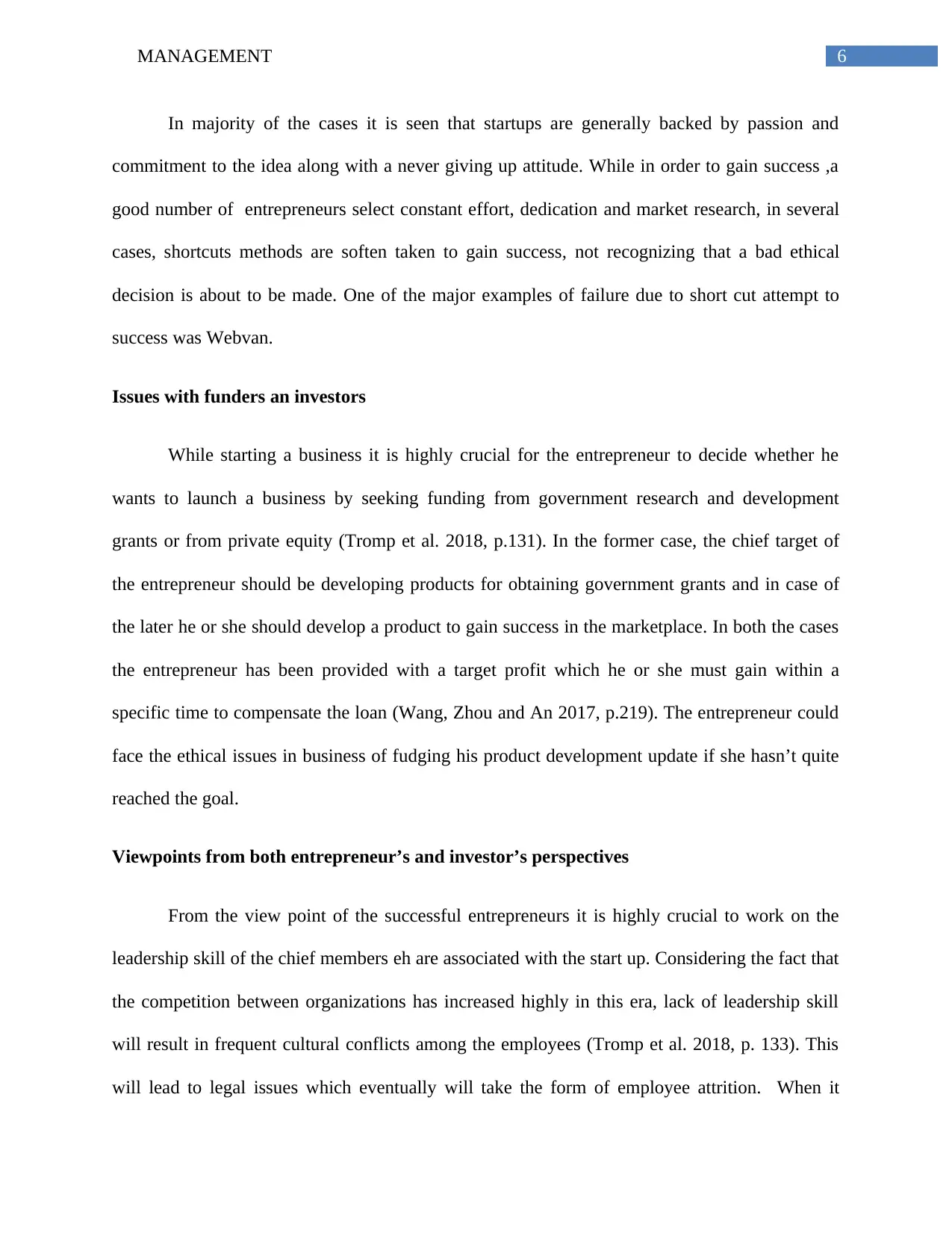
6MANAGEMENT
In majority of the cases it is seen that startups are generally backed by passion and
commitment to the idea along with a never giving up attitude. While in order to gain success ,a
good number of entrepreneurs select constant effort, dedication and market research, in several
cases, shortcuts methods are soften taken to gain success, not recognizing that a bad ethical
decision is about to be made. One of the major examples of failure due to short cut attempt to
success was Webvan.
Issues with funders an investors
While starting a business it is highly crucial for the entrepreneur to decide whether he
wants to launch a business by seeking funding from government research and development
grants or from private equity (Tromp et al. 2018, p.131). In the former case, the chief target of
the entrepreneur should be developing products for obtaining government grants and in case of
the later he or she should develop a product to gain success in the marketplace. In both the cases
the entrepreneur has been provided with a target profit which he or she must gain within a
specific time to compensate the loan (Wang, Zhou and An 2017, p.219). The entrepreneur could
face the ethical issues in business of fudging his product development update if she hasn’t quite
reached the goal.
Viewpoints from both entrepreneur’s and investor’s perspectives
From the view point of the successful entrepreneurs it is highly crucial to work on the
leadership skill of the chief members eh are associated with the start up. Considering the fact that
the competition between organizations has increased highly in this era, lack of leadership skill
will result in frequent cultural conflicts among the employees (Tromp et al. 2018, p. 133). This
will lead to legal issues which eventually will take the form of employee attrition. When it
In majority of the cases it is seen that startups are generally backed by passion and
commitment to the idea along with a never giving up attitude. While in order to gain success ,a
good number of entrepreneurs select constant effort, dedication and market research, in several
cases, shortcuts methods are soften taken to gain success, not recognizing that a bad ethical
decision is about to be made. One of the major examples of failure due to short cut attempt to
success was Webvan.
Issues with funders an investors
While starting a business it is highly crucial for the entrepreneur to decide whether he
wants to launch a business by seeking funding from government research and development
grants or from private equity (Tromp et al. 2018, p.131). In the former case, the chief target of
the entrepreneur should be developing products for obtaining government grants and in case of
the later he or she should develop a product to gain success in the marketplace. In both the cases
the entrepreneur has been provided with a target profit which he or she must gain within a
specific time to compensate the loan (Wang, Zhou and An 2017, p.219). The entrepreneur could
face the ethical issues in business of fudging his product development update if she hasn’t quite
reached the goal.
Viewpoints from both entrepreneur’s and investor’s perspectives
From the view point of the successful entrepreneurs it is highly crucial to work on the
leadership skill of the chief members eh are associated with the start up. Considering the fact that
the competition between organizations has increased highly in this era, lack of leadership skill
will result in frequent cultural conflicts among the employees (Tromp et al. 2018, p. 133). This
will lead to legal issues which eventually will take the form of employee attrition. When it
Paraphrase This Document
Need a fresh take? Get an instant paraphrase of this document with our AI Paraphraser
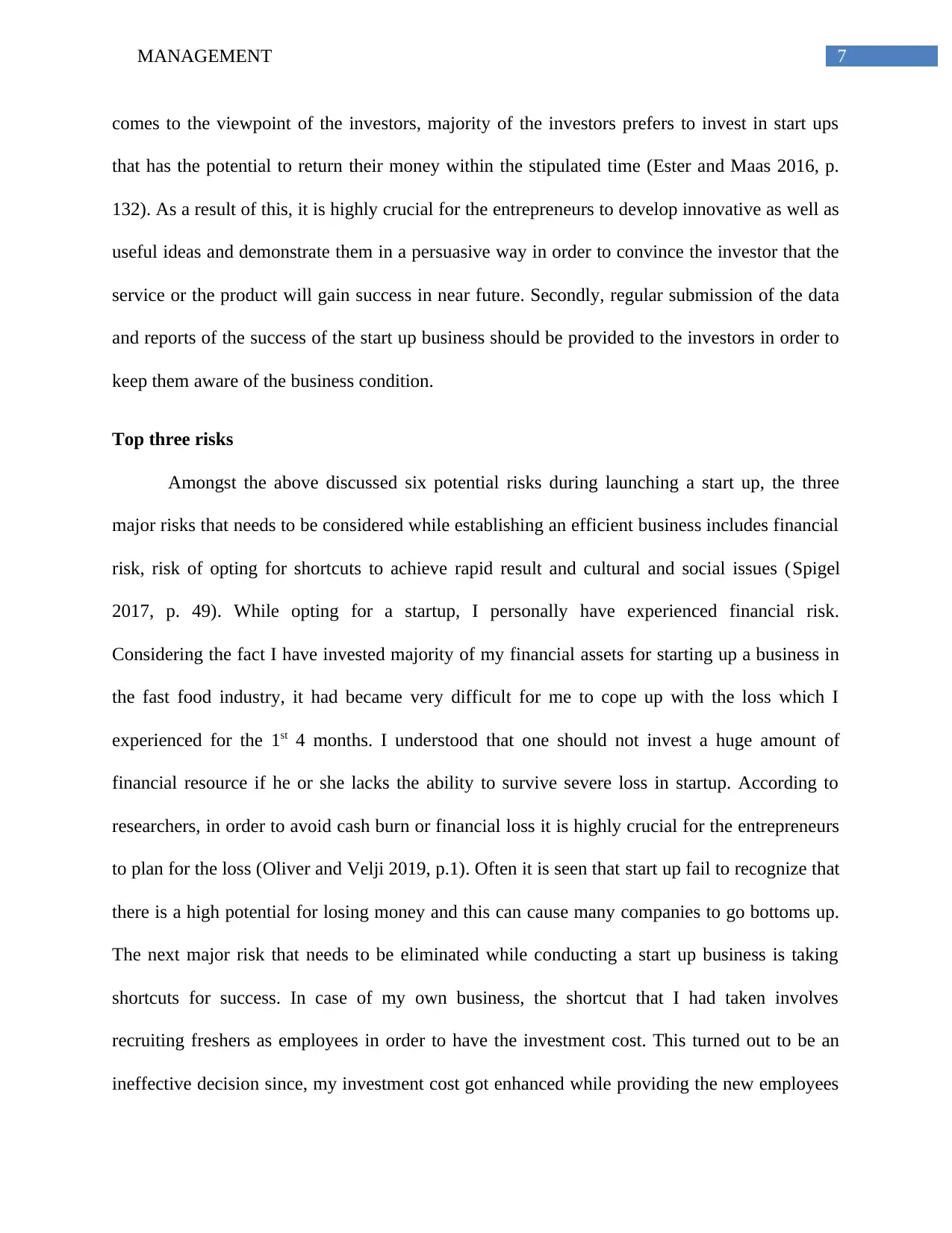
7MANAGEMENT
comes to the viewpoint of the investors, majority of the investors prefers to invest in start ups
that has the potential to return their money within the stipulated time (Ester and Maas 2016, p.
132). As a result of this, it is highly crucial for the entrepreneurs to develop innovative as well as
useful ideas and demonstrate them in a persuasive way in order to convince the investor that the
service or the product will gain success in near future. Secondly, regular submission of the data
and reports of the success of the start up business should be provided to the investors in order to
keep them aware of the business condition.
Top three risks
Amongst the above discussed six potential risks during launching a start up, the three
major risks that needs to be considered while establishing an efficient business includes financial
risk, risk of opting for shortcuts to achieve rapid result and cultural and social issues (Spigel
2017, p. 49). While opting for a startup, I personally have experienced financial risk.
Considering the fact I have invested majority of my financial assets for starting up a business in
the fast food industry, it had became very difficult for me to cope up with the loss which I
experienced for the 1st 4 months. I understood that one should not invest a huge amount of
financial resource if he or she lacks the ability to survive severe loss in startup. According to
researchers, in order to avoid cash burn or financial loss it is highly crucial for the entrepreneurs
to plan for the loss (Oliver and Velji 2019, p.1). Often it is seen that start up fail to recognize that
there is a high potential for losing money and this can cause many companies to go bottoms up.
The next major risk that needs to be eliminated while conducting a start up business is taking
shortcuts for success. In case of my own business, the shortcut that I had taken involves
recruiting freshers as employees in order to have the investment cost. This turned out to be an
ineffective decision since, my investment cost got enhanced while providing the new employees
comes to the viewpoint of the investors, majority of the investors prefers to invest in start ups
that has the potential to return their money within the stipulated time (Ester and Maas 2016, p.
132). As a result of this, it is highly crucial for the entrepreneurs to develop innovative as well as
useful ideas and demonstrate them in a persuasive way in order to convince the investor that the
service or the product will gain success in near future. Secondly, regular submission of the data
and reports of the success of the start up business should be provided to the investors in order to
keep them aware of the business condition.
Top three risks
Amongst the above discussed six potential risks during launching a start up, the three
major risks that needs to be considered while establishing an efficient business includes financial
risk, risk of opting for shortcuts to achieve rapid result and cultural and social issues (Spigel
2017, p. 49). While opting for a startup, I personally have experienced financial risk.
Considering the fact I have invested majority of my financial assets for starting up a business in
the fast food industry, it had became very difficult for me to cope up with the loss which I
experienced for the 1st 4 months. I understood that one should not invest a huge amount of
financial resource if he or she lacks the ability to survive severe loss in startup. According to
researchers, in order to avoid cash burn or financial loss it is highly crucial for the entrepreneurs
to plan for the loss (Oliver and Velji 2019, p.1). Often it is seen that start up fail to recognize that
there is a high potential for losing money and this can cause many companies to go bottoms up.
The next major risk that needs to be eliminated while conducting a start up business is taking
shortcuts for success. In case of my own business, the shortcut that I had taken involves
recruiting freshers as employees in order to have the investment cost. This turned out to be an
ineffective decision since, my investment cost got enhanced while providing the new employees
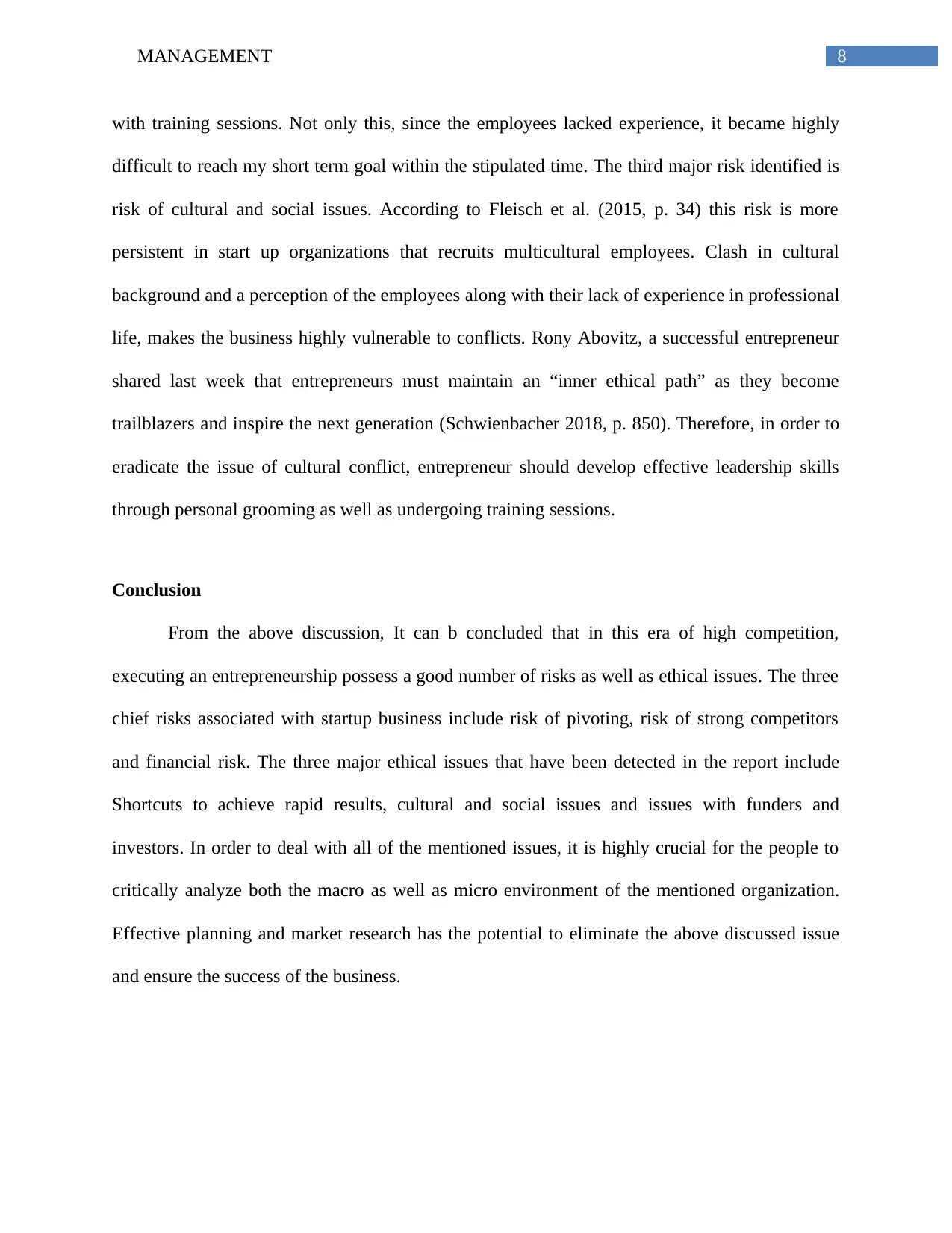
8MANAGEMENT
with training sessions. Not only this, since the employees lacked experience, it became highly
difficult to reach my short term goal within the stipulated time. The third major risk identified is
risk of cultural and social issues. According to Fleisch et al. (2015, p. 34) this risk is more
persistent in start up organizations that recruits multicultural employees. Clash in cultural
background and a perception of the employees along with their lack of experience in professional
life, makes the business highly vulnerable to conflicts. Rony Abovitz, a successful entrepreneur
shared last week that entrepreneurs must maintain an “inner ethical path” as they become
trailblazers and inspire the next generation (Schwienbacher 2018, p. 850). Therefore, in order to
eradicate the issue of cultural conflict, entrepreneur should develop effective leadership skills
through personal grooming as well as undergoing training sessions.
Conclusion
From the above discussion, It can b concluded that in this era of high competition,
executing an entrepreneurship possess a good number of risks as well as ethical issues. The three
chief risks associated with startup business include risk of pivoting, risk of strong competitors
and financial risk. The three major ethical issues that have been detected in the report include
Shortcuts to achieve rapid results, cultural and social issues and issues with funders and
investors. In order to deal with all of the mentioned issues, it is highly crucial for the people to
critically analyze both the macro as well as micro environment of the mentioned organization.
Effective planning and market research has the potential to eliminate the above discussed issue
and ensure the success of the business.
with training sessions. Not only this, since the employees lacked experience, it became highly
difficult to reach my short term goal within the stipulated time. The third major risk identified is
risk of cultural and social issues. According to Fleisch et al. (2015, p. 34) this risk is more
persistent in start up organizations that recruits multicultural employees. Clash in cultural
background and a perception of the employees along with their lack of experience in professional
life, makes the business highly vulnerable to conflicts. Rony Abovitz, a successful entrepreneur
shared last week that entrepreneurs must maintain an “inner ethical path” as they become
trailblazers and inspire the next generation (Schwienbacher 2018, p. 850). Therefore, in order to
eradicate the issue of cultural conflict, entrepreneur should develop effective leadership skills
through personal grooming as well as undergoing training sessions.
Conclusion
From the above discussion, It can b concluded that in this era of high competition,
executing an entrepreneurship possess a good number of risks as well as ethical issues. The three
chief risks associated with startup business include risk of pivoting, risk of strong competitors
and financial risk. The three major ethical issues that have been detected in the report include
Shortcuts to achieve rapid results, cultural and social issues and issues with funders and
investors. In order to deal with all of the mentioned issues, it is highly crucial for the people to
critically analyze both the macro as well as micro environment of the mentioned organization.
Effective planning and market research has the potential to eliminate the above discussed issue
and ensure the success of the business.
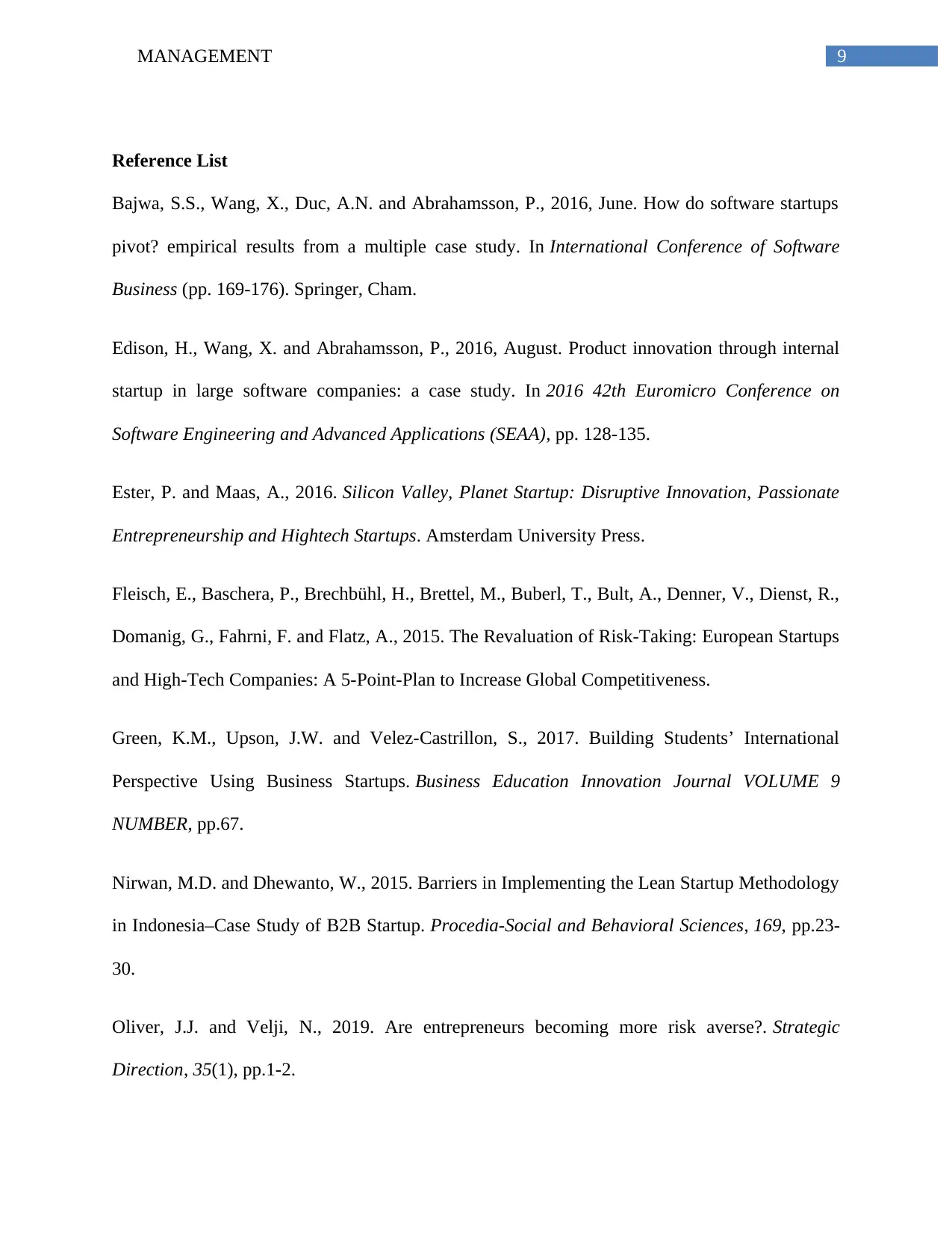
9MANAGEMENT
Reference List
Bajwa, S.S., Wang, X., Duc, A.N. and Abrahamsson, P., 2016, June. How do software startups
pivot? empirical results from a multiple case study. In International Conference of Software
Business (pp. 169-176). Springer, Cham.
Edison, H., Wang, X. and Abrahamsson, P., 2016, August. Product innovation through internal
startup in large software companies: a case study. In 2016 42th Euromicro Conference on
Software Engineering and Advanced Applications (SEAA), pp. 128-135.
Ester, P. and Maas, A., 2016. Silicon Valley, Planet Startup: Disruptive Innovation, Passionate
Entrepreneurship and Hightech Startups. Amsterdam University Press.
Fleisch, E., Baschera, P., Brechbühl, H., Brettel, M., Buberl, T., Bult, A., Denner, V., Dienst, R.,
Domanig, G., Fahrni, F. and Flatz, A., 2015. The Revaluation of Risk-Taking: European Startups
and High-Tech Companies: A 5-Point-Plan to Increase Global Competitiveness.
Green, K.M., Upson, J.W. and Velez-Castrillon, S., 2017. Building Students’ International
Perspective Using Business Startups. Business Education Innovation Journal VOLUME 9
NUMBER, pp.67.
Nirwan, M.D. and Dhewanto, W., 2015. Barriers in Implementing the Lean Startup Methodology
in Indonesia–Case Study of B2B Startup. Procedia-Social and Behavioral Sciences, 169, pp.23-
30.
Oliver, J.J. and Velji, N., 2019. Are entrepreneurs becoming more risk averse?. Strategic
Direction, 35(1), pp.1-2.
Reference List
Bajwa, S.S., Wang, X., Duc, A.N. and Abrahamsson, P., 2016, June. How do software startups
pivot? empirical results from a multiple case study. In International Conference of Software
Business (pp. 169-176). Springer, Cham.
Edison, H., Wang, X. and Abrahamsson, P., 2016, August. Product innovation through internal
startup in large software companies: a case study. In 2016 42th Euromicro Conference on
Software Engineering and Advanced Applications (SEAA), pp. 128-135.
Ester, P. and Maas, A., 2016. Silicon Valley, Planet Startup: Disruptive Innovation, Passionate
Entrepreneurship and Hightech Startups. Amsterdam University Press.
Fleisch, E., Baschera, P., Brechbühl, H., Brettel, M., Buberl, T., Bult, A., Denner, V., Dienst, R.,
Domanig, G., Fahrni, F. and Flatz, A., 2015. The Revaluation of Risk-Taking: European Startups
and High-Tech Companies: A 5-Point-Plan to Increase Global Competitiveness.
Green, K.M., Upson, J.W. and Velez-Castrillon, S., 2017. Building Students’ International
Perspective Using Business Startups. Business Education Innovation Journal VOLUME 9
NUMBER, pp.67.
Nirwan, M.D. and Dhewanto, W., 2015. Barriers in Implementing the Lean Startup Methodology
in Indonesia–Case Study of B2B Startup. Procedia-Social and Behavioral Sciences, 169, pp.23-
30.
Oliver, J.J. and Velji, N., 2019. Are entrepreneurs becoming more risk averse?. Strategic
Direction, 35(1), pp.1-2.
Secure Best Marks with AI Grader
Need help grading? Try our AI Grader for instant feedback on your assignments.
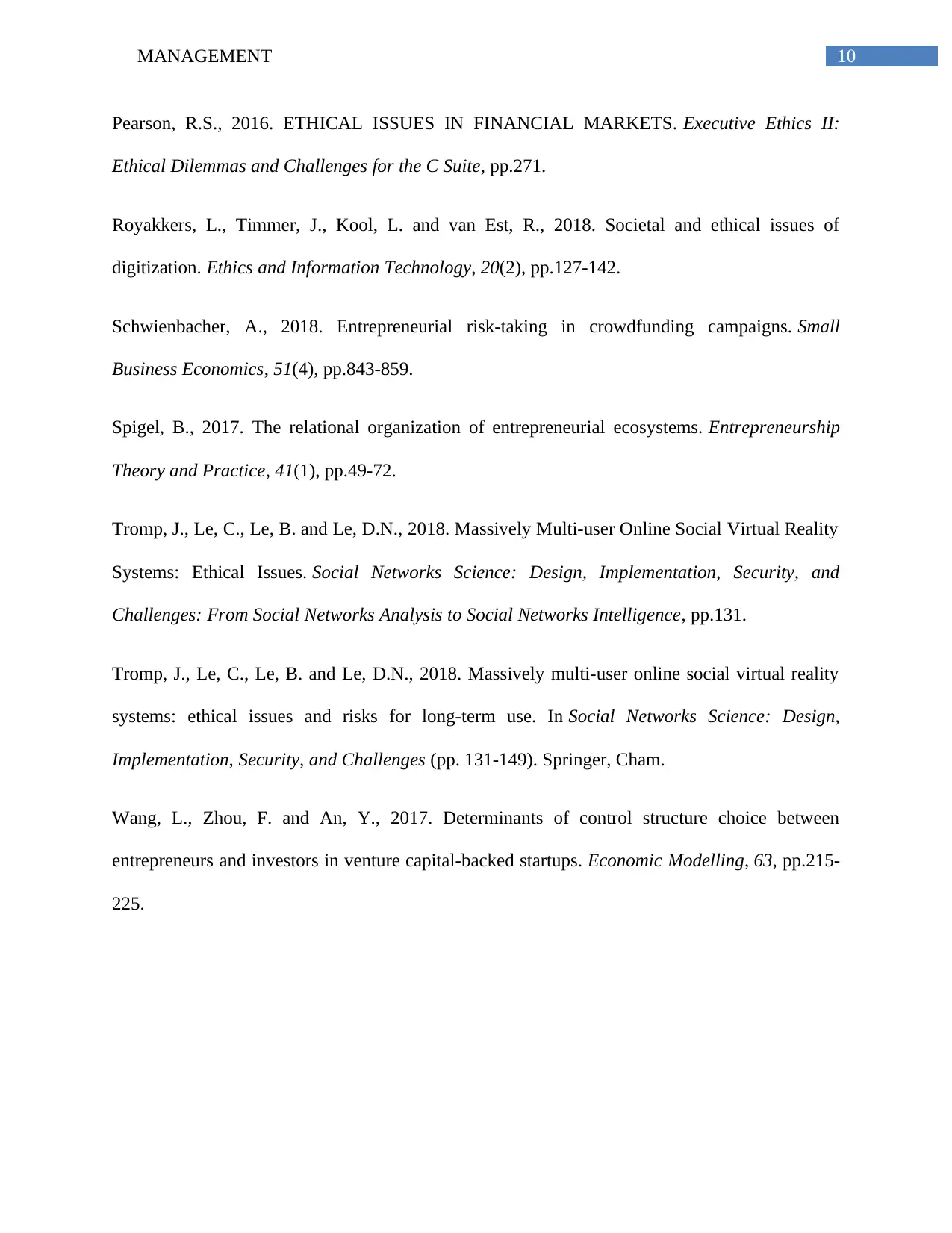
10MANAGEMENT
Pearson, R.S., 2016. ETHICAL ISSUES IN FINANCIAL MARKETS. Executive Ethics II:
Ethical Dilemmas and Challenges for the C Suite, pp.271.
Royakkers, L., Timmer, J., Kool, L. and van Est, R., 2018. Societal and ethical issues of
digitization. Ethics and Information Technology, 20(2), pp.127-142.
Schwienbacher, A., 2018. Entrepreneurial risk-taking in crowdfunding campaigns. Small
Business Economics, 51(4), pp.843-859.
Spigel, B., 2017. The relational organization of entrepreneurial ecosystems. Entrepreneurship
Theory and Practice, 41(1), pp.49-72.
Tromp, J., Le, C., Le, B. and Le, D.N., 2018. Massively Multi-user Online Social Virtual Reality
Systems: Ethical Issues. Social Networks Science: Design, Implementation, Security, and
Challenges: From Social Networks Analysis to Social Networks Intelligence, pp.131.
Tromp, J., Le, C., Le, B. and Le, D.N., 2018. Massively multi-user online social virtual reality
systems: ethical issues and risks for long-term use. In Social Networks Science: Design,
Implementation, Security, and Challenges (pp. 131-149). Springer, Cham.
Wang, L., Zhou, F. and An, Y., 2017. Determinants of control structure choice between
entrepreneurs and investors in venture capital-backed startups. Economic Modelling, 63, pp.215-
225.
Pearson, R.S., 2016. ETHICAL ISSUES IN FINANCIAL MARKETS. Executive Ethics II:
Ethical Dilemmas and Challenges for the C Suite, pp.271.
Royakkers, L., Timmer, J., Kool, L. and van Est, R., 2018. Societal and ethical issues of
digitization. Ethics and Information Technology, 20(2), pp.127-142.
Schwienbacher, A., 2018. Entrepreneurial risk-taking in crowdfunding campaigns. Small
Business Economics, 51(4), pp.843-859.
Spigel, B., 2017. The relational organization of entrepreneurial ecosystems. Entrepreneurship
Theory and Practice, 41(1), pp.49-72.
Tromp, J., Le, C., Le, B. and Le, D.N., 2018. Massively Multi-user Online Social Virtual Reality
Systems: Ethical Issues. Social Networks Science: Design, Implementation, Security, and
Challenges: From Social Networks Analysis to Social Networks Intelligence, pp.131.
Tromp, J., Le, C., Le, B. and Le, D.N., 2018. Massively multi-user online social virtual reality
systems: ethical issues and risks for long-term use. In Social Networks Science: Design,
Implementation, Security, and Challenges (pp. 131-149). Springer, Cham.
Wang, L., Zhou, F. and An, Y., 2017. Determinants of control structure choice between
entrepreneurs and investors in venture capital-backed startups. Economic Modelling, 63, pp.215-
225.
1 out of 11
Related Documents
Your All-in-One AI-Powered Toolkit for Academic Success.
+13062052269
info@desklib.com
Available 24*7 on WhatsApp / Email
![[object Object]](/_next/static/media/star-bottom.7253800d.svg)
Unlock your academic potential
© 2024 | Zucol Services PVT LTD | All rights reserved.





